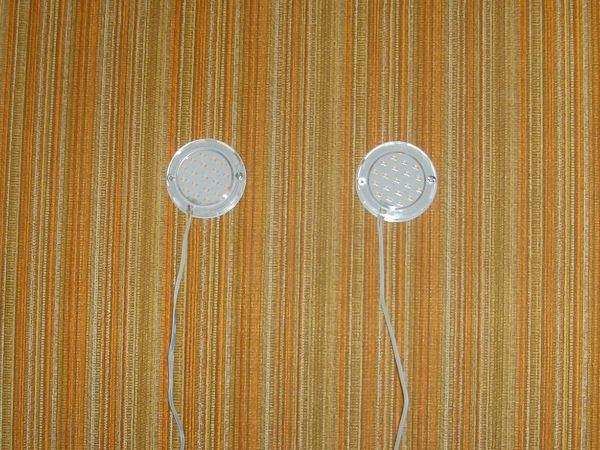
This is not how you normally see the new LED lights. They are used for indirect lighting, usually mounted under or over shelves. It is not recommended to look straight at them, I doubt it is dangerous but it certainly is uncomfortable.
Electricity has been quite well understood for more than a century, and I remember LED – light emitting diodes – used as on/off indicators on radios etc in my youth, more than 30 years ago. Not much later did I buy a nightlight using the same technology. It was faint, but used almost no power. It was the only light source that converted electricity to light so efficiently, losing almost nothing as heat in the process.
It was only the last decade or less that I started to get LED-based torchlights and head-mounted lights. By now the high-energy blue LEDs had been invented. While these had more energy loss in the conversion, they were still more efficient than the competition. Coating high-energy LEDs with a phosphorescent material allowed white light instead of blue, but some energy was lost in the process.
Only the last couple years have LED-based light bulbs been affordable and widely available enough that I could replace the incandescent bulbs in my apartment with white LED bulbs. These fit in the same sockets, but have a converter in their base which also draws power and produces a fair amount of heat. Depending on the type and brightness, LED bulbs use from 20% down toward 10% of the electricity used by a corresponding old-fashioned incandescent bulb. They also are expected to last 15-30 years, so it should be a good investment even at today’s prices. On the other hand, prices are still sliding, so it will likely become even cheaper in the future.
The practice of retrofitting, simply replacing incandescent bulbs with LED, is not optimal. To get that much brightness in the shape and size of the old bulb, you have to pack the LEDs densely together and close to the heat-producing converter. Since we mostly are lazy and hate change, this cannot be avoided, and there will probably be further progress in this area. But it is already possible to get more light (and less heat) out of the same electricity, simply by changing the size and shape of the light source.
The usually circular plates with many small diodes are sold for uplight and downlight, to be mounted under or on top of shelves, cupboards etc so as to cast their light up toward the ceiling or down toward the floor, providing indirect lighting to nearby parts of the room. Because they don’t need to be packed tightly, they don’t have a heating problem and are more effective and less likely to fade or break over time. They add very little heat and use little electricity.
I recently bought a pack with three such light circles, although it can be expanded to five. I am impressed with how much light they give, and they stay cool. I hope eventually, when the incandescent bulb is a thing of the past, flat-panel LED lighting will become the standard.
One can imagine bars or rectangles with rows of diodes, covered with a semi-opaque cover that diffuses the light enough to hide the individual diodes and not make the lamp painful to look at. These could be mounted in full view and provide a stylish illumination in new or renovated homes, either fixed to wall or ceiling, or vertically as movable lamps, perhaps shaped like a “staff”, with the power transformer in the dark lower part and a brightly shining upper section to illuminate the surrounding room. Or if that is too bright, another possible form is a “platter” pointing up toward the ceiling, causing a bright spot there to make the room bright. I have not seen these shapes yet, but I would not be surprised if they are already out there. The shape of the bulb has survived so far, but I don’t expect it to last forever.
